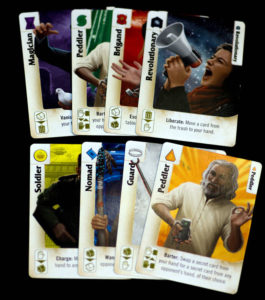 Being from the midwest, trick-taking games are part of my blood. I’ve played more games of Euchre than I care to remember. In modern gaming today, there are a lot of new games that take the trick taking formula and build more mechanisms around it.
Being from the midwest, trick-taking games are part of my blood. I’ve played more games of Euchre than I care to remember. In modern gaming today, there are a lot of new games that take the trick taking formula and build more mechanisms around it.
Trickster: Champions of Time will be immediately familiar to anyone with trick-taking experience even though it adds a whole new element on top of it. Compared to many other games, it feels pretty far from the roots of trick-taking.
Trickster: Champions of Time plays 2-6 players in about 45 minutes. It plays best with 4 or more.
Gameplay Overview:
Trickster: Champions of Time comes with 14 different character cards, each illustrated wonderfully by Beth Sobel. Each character has a card in each of the 8 colors in the game and 7 characters are chosen for each game.

In Trickster, instead of the lead card determining what everyone else plays, the second card sets the rules for each trick. The second player is considered the “trickster.” They can play any card in their hand, regardless of what was led. If it is the same character/color, everyone must now play that character/color. However, if it matches neither character or color, players must attempt to play cards that do not match color or characters of any card played before them.
If a player cannot follow the rule, they take all of the cards from the pot and put them in their tableau, which may score you points at the end of the round. In Trickster, the fewest points is the winner. The trickster must take all of the cards from the pot if all players successfully play a card. Each card also has a special power that is activated when played. Some will add cards to the pot or move cards from one player’s hand or tableau to another.
The round ends when one player is out of cards in hand. Any cards still in your hand get added to your tableau and then you score one point for every card in your tableau. However, if you have the most of a particular color, you can discard those and they don’t count against you. The game ends after three rounds and the player with the least points is the winner.

Game Experience:
Trickster adds a whole lot of player interaction to the trick-taking genre. Most of the tactics in the game come from the special abilities of the character cards. Allowing players to swap cards with other players, or move cards from one player’s tableau to another in the middle of the trick, adds depth and a little bit of take-that. You can’t really look at your opening hand and determine that it is strong or not – it is very dependent on what the Trickster plays.

Some of the character cards are more fun to play with than others. This is one of the rare games I’ve enjoyed the basic setup more than the recommended advanced version. It seemed to include many more cards that involved directly moving things around, while the advanced characters focused more on crafting your own hand and less interacting with other players. You can mix and match characters however you’d like to create some interesting combinations.
The downside is those combinations don’t always work very well together. If you can’t completely resolve a character’s effect, you don’t do it at all. So if the ability uses a card from the top of the deck and the deck has been depleted already, you don’t do anything. Even with the recommended setups, it seemed like at least half of the time the character powers didn’t actually work.
For the first few tricks of each hand you generally try to just avoid getting any cards in your tableau. The tactics kick up a little bit only when you’ve accumulated some cards as you try to get rid of them. Or perhaps you try to collect a bunch of cards, since they don’t count against you if you have the most of the color. But there is a ton of information hidden in players’ hands as unplayed cards get added to their tableau at the end of the round, so that can be a dangerous approach.
There are variants for 2 and 3 player games which include a timeline hand that will “lead” a card for each trick. This plays out OK, but I prefered the game with 4 or more players.
Final Thoughts:
While Trickster: Champions of Time is similar mechanically to trick-taking games, it plays out much more like a tableau building or set collection game. The ability to “shoot the moon” and take a bunch of cards hoping to have the most is an interesting press your luck element.
There is a lot of direct player interaction and that may be good or bad depending on how you feel about it. I think it’s a neat change of pace on a traditional formula. However Trickster can drag on a little long since every player has to take their action every time they play a card. But if you like trick-taking or just messing with other players, Trickster: Champions of Time is worth checking out.
Final Score: 3.5 Stars – A tableau-building take on trick-taking with lots of direct player interaction.
 Hits:
Hits:
• Lots of variability on the setup
• Familiar concept but doesn’t feel exactly like any other game
• Great artwork
Misses:
• Can drag on longer than it should
• Hard to find a great mix of characters to use






















